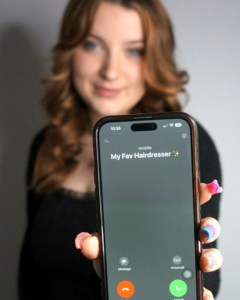The Cosmetology School Glossary: 15 Beauty Terms Every Future Stylist Needs to Know
When you’re just starting out in cosmetology school, it can feel like everyone’s speaking a different language—balayage, porosity, blunt cut—what do all these beauty terms mean?
Don’t worry, we’ve all been there.
About to enroll? Knee-deep in your first color theory class?
Whatever the case, understanding these beauty terms will boost your confidence and ensure you feel more at home behind the chair.
Think of it like learning the alphabet before becoming a bestselling author. Instead, you’re learning these beauty terms before becoming a top 20 stylist.
Having this cosmetology school glossary under your belt, you’ll be set up for success from day one.
At TENAJ Salon Institute, we believe that mastering the lingo is the first step to becoming a beauty pro.
So, we’ve rounded up 15 key cosmetology terms every future stylist should know—plus, we’ll break them down in plain English so they actually make sense.
But wait, there’s more! Read to the very bottom for two bonus sets of terms you should know as an aspiring cosmetologist.
Shall we explore your new favorite vocabulary list?

Why Beauty Terms Matter
To start, what’s the point in knowing these terms before cosmetology school? Isn’t that what cosmetology is for?
We thought you’d never ask…
Let’s be real—walking into cosmetology school without knowing the lingo is like showing up to a foreign country without understanding a word of the language. You might get by with gestures and smiles, but you’ll miss out on so much.
Getting familiar with key beauty terms early on can:
- Help you feel more assured and prepared from the start
- Make it easier to follow along during hands-on demos and lessons
- Allow you to communicate clearly with instructors, classmates, and guests
- Stay ahead of the curve when it comes time to ace your licensing exam (because yes, the wording matters!)
15 Beauty Terms Every Future Stylist Needs to Know
1. Balayage
A French word that means “to sweep”…and that’s exactly what you’ll be doing. The more you know!
Balayage is a hand-painted highlighting technique that creates soft, natural-looking dimension without harsh lines.
Imagine sun-kissed hair with a lived-in glow. It’s a guest favorite for low-maintenance color that still looks luxe.
Balayage takes some practice to perfect, but once you’ve got it down, your books will stay full!
2. Porosity
Porosity is your hair’s ability to absorb and retain moisture.
There are three levels:
- low
- normal
- high
and each one affects how color, products, and treatments work on your guest’s hair.
Knowing how porous someone’s hair is lets you tailor their services for the best results.
Hair that dries super fast? Probably high porosity. Takes forever to dry? Likely low porosity.
3. Blunt Cut
A blunt cut is a haircut where all the ends are trimmed to the same length, creating a super clean, straight edge.
It’s sleek, modern, and always makes a statement.
We’re talking lobs, bobs, and jaw-dropping one-length styles.
You’ll use this foundational cutting technique all the time. Particularly for those guests who say, “I want something sharp and edgy!”
4. Developer
Developer (aka hydrogen peroxide) is the magic mix that activates hair color or lightener.
It comes in different volumes (10, 20, 30, 40) that determine how much lift or deposit you’ll get.
Choosing the right one depends on your guest’s hair goals, and what their hair can actually handle.
Rule of thumb: the higher the volume, the more lift—but also, the more potential damage. Choose wisely!
5. Layers
Layers are different lengths of hair cut throughout the head to add movement, shape, and volume.
They can be soft and subtle or bold and choppy.
Layers help you customize a cut to flatter your client’s face shape and texture.
Long layers are great for keeping length while still giving fine hair a fuller look.
6. Toner
Toner is the secret weapon for perfecting hair color after lightening.
It neutralizes unwanted tones, like brassiness in blondes, and enhances the final shade.
It can be used right after bleaching or between appointments to keep color looking fresh.
Think of toner as the Instagram filter for hair color. It adjusts warmth, depth, and vibrancy so the color is just right.
7. Foils
Foils are thin sheets (usually aluminum) used to isolate sections of hair during color services, especially highlighting.
They help control placement, prevent bleeding, and speed up processing by holding in heat.
Foil work takes precision. Placement is everything if you want a natural or bold result.
8. Elevation
Elevation refers to the angle at which you lift the hair while cutting.
It affects the shape, volume, and movement of the final look.
Low elevation = heavier lines.
High elevation = more layers and softness.
Your comb and fingers are your measuring tools. Get used to using them as guides!
9. Overdirecting
Overdirecting is when you pull a section of hair away from its natural fall before cutting.
It’s used to create volume, length, or movement in specific areas.
This technique is key in advanced haircuts like face-framing layers or long bobs.
Overdirection enables you to “build” shape into a cut rather than just removing length.
10. Cuticle
The cuticle is the outermost layer of the hair shaft.
It acts like shingles on a roof, protecting the inner layers from damage.
If the cuticle is raised or damaged, hair becomes frizzy, dull, or more prone to breakage.
Healthy cuticle = shiny, smooth, manageable hair. Always treat it with care, especially during color services.
11. Diffuser
A diffuser is an attachment for a blow dryer that distributes airflow more evenly.
It’s really useful for curly or wavy hair, as it enhances natural texture without causing frizz or disrupting curl patterns.
Perfect for guests who want big, bouncy curls without the heat damage.
12. Single-Process Color
Single-process color is when you apply one color all over in one step.
It’s used for covering gray, deepening natural tones, or going darker.
Quick, classic, and beginner-friendly.
Looking for a low-maintenance color service to master first? Start here!
13. Texturizing
Texturizing involves removing bulk or creating movement in a haircut using special techniques or shears.
It can soften a blunt edge, add lift, or cause thick hair to feel lighter.
Not every haircut needs it, but when done right, texturizing can take a style from “meh” to magic.
14. Demi-Permanent Color
Demi-permanent color lasts longer than a gloss but fades over time.
It deposits color without lightening and is great for blending grays, enhancing tones, or refreshing faded color.
It’s ammonia-free and gentler on hair than permanent color!
15. Trichology
Trichology is the science of hair and scalp health.
It covers everything from how hair grows to why it falls out—and what you can do about it.
This specialty can be a useful assistant in spot and address issues like dandruff, hair thinning, oily scalps, and irritation.
Having an understanding of trichology takes your skills to the next level, giving you an edge in caring for your guests.
When you know the scalp is just as important as the hair, you’re treating the whole picture. And that’s what makes a standout stylist.
From Glossary to Greatness
Learning cosmetology terms might feel overwhelming at first, but just like with cutting or color, it gets easier the more you practice.
Print this glossary out. Keep it handy. And remember, every master stylist was once a student too.
BONUS Beauty Terms to Know
Are you the type that likes to go the extra mile? Here are a few more terms you can add to your list:
Hair Elasticity – how far hair can stretch without breaking
Healthy hair has bounce, not breakage.
Keratin Treatment – a smoothing treatment that tames frizz
A holy grail of frizz fighting.
Patch Test – a safety test to check for allergic reactions to products
Better safe than sorry. Never forget to test before you treat.
pH Balance – the measure of how acidic or alkaline hair and scalp are (basically, how “in balance” your hair and scalp’s natural chemistry is to stay healthy and happy)
Keeping pH balanced means your guest’s hair is in its best shape .
BONUS BONUS: Business Beauty Terms to Know
Have you thought about the business side of being a hairstylist? These biz terms will have you thinking like a beauty boss in no time:
Consultation – the (super important!) conversation you have with a client before starting any service. It’s your chance to understand their goals, assess their hair, set expectations, and build trust. Great consultations = happy guests + fewer surprises for you.
Guest Retention – the ability to keep guests coming back regularly
Loyal guests yields a steady income and happy referrals.
Retail Commission – a percentage you earn from selling products to clients
Selling the right shampoo can add a good add-on to your paycheck.
Booth Rental – renting your own station in a salon and working independently
Freedom to be your own boss, but also your own accountant.
Upselling – suggesting add-ons like deep conditioning or brow waxing
A little extra service leads to big guest satisfaction.
Prebooking – scheduling the client’s next appointment before they leave
Maintain a full calendar (and wallet).
Walk Into Beauty School With Confidence
It’s all about feeling less “Wait, what?” and more “I’ve got this.” Learning the basics now means you walk in ready to learn—not trying to play catch-up.
At TENAJ Salon Institute, our comprehensive 1200-hour program equips you with the language, knowledge, and skills to behave like a seasoned pro from the beginning.
These beauty terms are just the beginning of your cosmetology journey. As you make your way through school, you’ll add hundreds more words to your professional vocab.
Consider this your first cheat sheet (you’re welcome!)
Want to learn how TENAJ Salon Institute teaches you to master these concepts in real-world salon settings? Schedule a tour with us, or request more info here.
Want to support our students on their road to cosmetology licensure? Book an appointment today.
